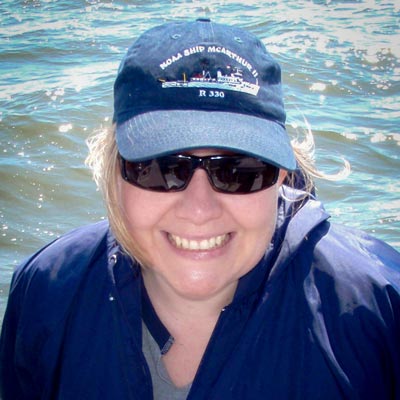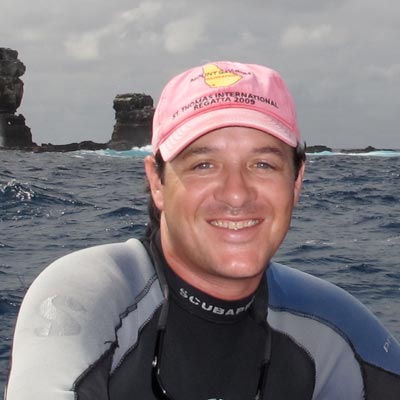CiguaPIRE
Linking the chemical and biological diversity of epiphytic dinoflagellates in tropical oceans: Advancing global understanding on the origin of ciguatera.
Benthic Harmful Algal Blooms (HABs)

Harmful algal blooms (HABs) occur when algae grow out of control and have harmful effects on the shellfish, fish, mammals, and birds associated with the aquatic environment the bloom occurs in. Some of the algae that produce HABs also produce toxins that detrimentally impact organisms that use the water in which they grow. Toxic effects can also impact humans, and when they do, they can be very debilitating. Not all of the algae that bloom are those that live in the water column as members of the plankton (e.g., Karenia brevis, the dinoflagellate that causes “red tides” in the Gulf of Mexico). In fact, some HAB species live in the benthos (bottom) region of the water column and can grow on various benthic substrates including sediment, coral, macroalgae, and/or seagrasses. These species are referred to as Benthic HABs.
Learn MoreResearch Goals

1. Evaluate Community Diversity
Evaluate epiphyte and Gambierdiscus community diversity and macrophyte host selectivity across spatio-temporal scales and environmental gradients in coral reef ecosystems

2. Characterize Meta-Metabolome
Characterize the meta-metabolome of these communities, structurally elucidate key metabolites, and develop methods to evaluate their toxicity and functional role

3. Utilize Chemical Biomarkers
Utilize chemical biomarkers (toxins, lipids, stable isotopes) in bio-indicator species (primary producers and consumers) and model their fate in reef food webs
Research Overview
Coral reef ecosystems are among the most biodiverse habitats on earth, providing ecosystem services and fishery resources critical to coastal communities. A significant threat to utilizing this resource is ciguatera fish poisoning (CFP), which is estimated to affect more than 10% of island populations globally, and is the most prevalent non-bacterial seafood illness worldwide. Ciguatoxins (CTXs) are produced by toxigenic phenotypes of the benthic dinoflagellate Gambierdiscus (i.e., super-bugs) and enter reef food webs via herbivorous grazing on macroalgal substrates. Mechanisms and identification of toxins are largely unknown, but their elucidation is critical to the development of monitoring approaches for public health protection. The central hypothesis of this PIRE program is that toxigenic benthic dinoflagellates produce a stable meta-metabolome allowing them to prosper in an otherwise unstable environment driven by shifts in the epiphytic flora, available substrates, and environmental conditions. Moreover, the stability and advantages gained in this meta-metabolome are universal across toxigenic genera and applicable to many (sub)tropical reef environments.
Read More About Our ResearchEducation Goals

1. Graduate Student Exchange
Expose students to the importance of multidisciplinary and collaborative research through graduate student exchange program and methods harmonization workshops
Learn More
2. Broaden Marine Education
Transform marine education within and across departments and institutions by broadening the involvement of researchers and other participants from underrepresented groups
Learn More
3. Develop Science Curricula
Develop engaging and informative information to integrate into science curricula
Learn MoreEducation Overview
The educational component of this project includes five elements that cross multiple levels of education and training initiative engaging on a regional, US-wide, and International level:
- K-12 educational enrichment through development of classroom activities, and development of displays at museums, aquariums, and visitor centers
- Teacher workshops to bring truly integrated STEM activities to the classroom using the ‘train the trainer’ model
- Undergraduate US training and international field class opportunity
- Reciprocal graduate exchange program
- Methods harmonization workshop.
Partnerships for International Research and Education (PIRE)

Partnerships for International Research and Education (PIRE) is a National Science Foundation (NSF) program that funds international research and educational activities across all NSF-supported disciplines. The primary goal of PIRE is to support high quality projects in which advances in research and education could not occur without international collaboration. PIRE promotes excellence in science and engineering through international collaboration and facilitates development of a diverse, globally-engaged, U.S. science and engineering workforce.
U.S. INVESTIGATORS

Alison Robertson, Ph.D.
University of South Alabama
Dauphin Island Sea Lab
Mobile, AL, USA

Mindy L. Richlen, Ph.D.
Woods Hole Oceanographic Institute
Woodshole, MA, USA

Deana Erdner, Ph.D.
UT Marine Institute
Port Aransas, TX, USA

Michael L. Parsons, Ph.D
Florida Gulf Coast University
Fort Myers, FL, USA

Tyler B. Smith, Ph.D
University of the Virgin Islands
St. Thomas, USVI, USA

Donald M. Anderson, Ph.D
Woods Hole Oceanographic Institute
Woodshole, MA, USA

Kenneth Heck, Ph.D
Dauphin Island Sea Lab
Dauphin Island, AL, USA
INTERNATIONAL COLLABORATORS
Carlos Alonso Hernandez, CEAC/CITMA
Silvio Uhlig, NVI
Ingunn A. Samdal, NVI
Christiane K. Faste, NVI
Frode Rise, Univ Oslo
Leo Lai Chan, City U
Jiajun Wu, SKLMP & City U
Angela Capper, HWU-ICIT
Kathryn McMahon, ECU
Paul Lavery, ECU
Megan Huggett, Newcastle University
Pearse McCarron, NRCC
Christopher Miles, NRCC
Andrew Turner, CEFAS
EDUCATORS

Carla Curran, Ph.D
Broader Impacts, LLC

Elizabeth Day-Miller
Bridgewater Education Consulting, LLC
Bridgewater, VA

Tina Miller-Way, Ph.D.
Dauphin Island Sea Lab
Dauphin Island, AL, USA

Laura Frost, Ph.D.
Florida Gulf Coast University
Fort Myers, FL, USA
COLLABORATORS

















